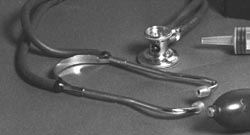
A GIFT FOR THE DYING
Suzanne Egle
Photos by Malik Rahsaan
 She
coughs, choking on the powder, trying to clear her lungs, but she is so
weakened from lung cancer that the effort is futile. Her frail body shudders
with each spasm as the relentless cough takes control over her. The ordeal
lasts about ten minutes; it seems interminable.
She
coughs, choking on the powder, trying to clear her lungs, but she is so
weakened from lung cancer that the effort is futile. Her frail body shudders
with each spasm as the relentless cough takes control over her. The ordeal
lasts about ten minutes; it seems interminable.
![]()
![]() "I
guess youíre not happy to see me today, huh?" says her hospice nurse, who
had ordered the medicine. She leans in close, gently patting her patientís
leg. The old woman smiles and nods. The tension breaks at last.
"I
guess youíre not happy to see me today, huh?" says her hospice nurse, who
had ordered the medicine. She leans in close, gently patting her patientís
leg. The old woman smiles and nods. The tension breaks at last.
![]()
![]() A
Los Angeles area hospice nurse, who for this article asked that her real
name not be used, Katie Curtis has dedicated her life to the dying.
A
Los Angeles area hospice nurse, who for this article asked that her real
name not be used, Katie Curtis has dedicated her life to the dying.
![]()
![]() "Here
drink some water," she says tenderly. The woman sips slowly from her porcelain
cup as the nurse asks the caregiver for some vital statistics for the chart.
"Here
drink some water," she says tenderly. The woman sips slowly from her porcelain
cup as the nurse asks the caregiver for some vital statistics for the chart.
"TODAY WAS AN EASY DAY."
![]()
![]() This
patient is one of three Curtis will see today in her work as a hospice
nurse, a job where Curtis will drive up to 70 miles, check vital signs,
insert or change catheters and IVs, take blood and urine samples, order
pain medication, change wound bandages, comfort terminally ill patients
and their family members, and coordinate a team of people to help families
cope with the dying process.
This
patient is one of three Curtis will see today in her work as a hospice
nurse, a job where Curtis will drive up to 70 miles, check vital signs,
insert or change catheters and IVs, take blood and urine samples, order
pain medication, change wound bandages, comfort terminally ill patients
and their family members, and coordinate a team of people to help families
cope with the dying process.
![]()
![]() Yet
she manages her work with a balance of cheerfulness and compassion, strength
and commitment to the philosophy she believes in: to do everything in her
power to provide comfort and support for patients nearing the end of their
life.
Yet
she manages her work with a balance of cheerfulness and compassion, strength
and commitment to the philosophy she believes in: to do everything in her
power to provide comfort and support for patients nearing the end of their
life.
![]()
![]() "Today
was an easy day," says Curtis driving home after a day that had her driving
30 miles round trip within a six hour time span, not including the morning
prep time calling the patients to set up the visit, and then at the end
of the day spending an average of two hours completing paperwork.
"Today
was an easy day," says Curtis driving home after a day that had her driving
30 miles round trip within a six hour time span, not including the morning
prep time calling the patients to set up the visit, and then at the end
of the day spending an average of two hours completing paperwork.
![]()
![]() Curtis,
45, works with the team of hospice workers in a home hospice agency in
the Los Angeles area. The team includes a manager, nurses, bath nurses,
social workers, chaplaincy, volunteers and a medical director. The program,
funded by the federal government, provides free service to the terminally
ill who can enter hospice when their prognosis is six months or less. It
pays for all the prescriptions related to their primary disease to manage
pain, sleep, or anxiety, and to manage symptoms. It also covers all the
equipment a home health patient may need, such as a hospital bed, wheelchair,
or oxygen. A registered nurse is on call 24 hours a day, seven days a week.
Curtis,
45, works with the team of hospice workers in a home hospice agency in
the Los Angeles area. The team includes a manager, nurses, bath nurses,
social workers, chaplaincy, volunteers and a medical director. The program,
funded by the federal government, provides free service to the terminally
ill who can enter hospice when their prognosis is six months or less. It
pays for all the prescriptions related to their primary disease to manage
pain, sleep, or anxiety, and to manage symptoms. It also covers all the
equipment a home health patient may need, such as a hospital bed, wheelchair,
or oxygen. A registered nurse is on call 24 hours a day, seven days a week.